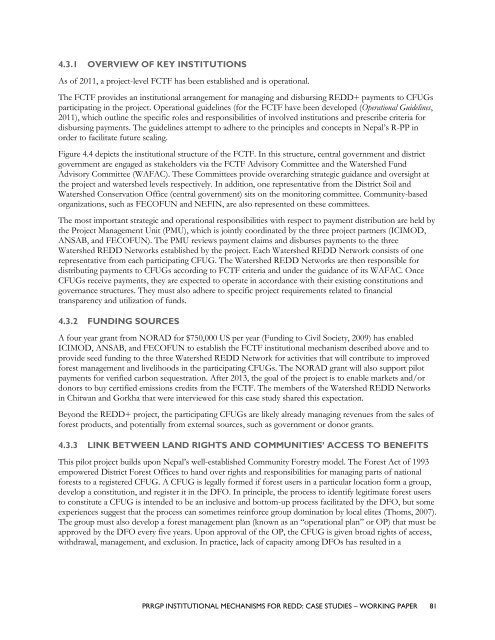Institutional Mechanisms for REDD+ - Case Studies Working Paper
Institutional Mechanisms for REDD+ - Case Studies Working Paper
Institutional Mechanisms for REDD+ - Case Studies Working Paper
Create successful ePaper yourself
Turn your PDF publications into a flip-book with our unique Google optimized e-Paper software.
4.3.1 OVERVIEW OF KEY INSTITUTIONS<br />
As of 2011, a project-level FCTF has been established and is operational.<br />
The FCTF provides an institutional arrangement <strong>for</strong> managing and disbursing <strong>REDD+</strong> payments to CFUGs<br />
participating in the project. Operational guidelines (<strong>for</strong> the FCTF have been developed (Operational Guidelines,<br />
2011), which outline the specific roles and responsibilities of involved institutions and prescribe criteria <strong>for</strong><br />
disbursing payments. The guidelines attempt to adhere to the principles and concepts in Nepal‘s R-PP in<br />
order to facilitate future scaling.<br />
Figure 4.4 depicts the institutional structure of the FCTF. In this structure, central government and district<br />
government are engaged as stakeholders via the FCTF Advisory Committee and the Watershed Fund<br />
Advisory Committee (WAFAC). These Committees provide overarching strategic guidance and oversight at<br />
the project and watershed levels respectively. In addition, one representative from the District Soil and<br />
Watershed Conservation Office (central government) sits on the monitoring committee. Community-based<br />
organizations, such as FECOFUN and NEFIN, are also represented on these committees.<br />
The most important strategic and operational responsibilities with respect to payment distribution are held by<br />
the Project Management Unit (PMU), which is jointly coordinated by the three project partners (ICIMOD,<br />
ANSAB, and FECOFUN). The PMU reviews payment claims and disburses payments to the three<br />
Watershed REDD Networks established by the project. Each Watershed REDD Network consists of one<br />
representative from each participating CFUG. The Watershed REDD Networks are then responsible <strong>for</strong><br />
distributing payments to CFUGs according to FCTF criteria and under the guidance of its WAFAC. Once<br />
CFUGs receive payments, they are expected to operate in accordance with their existing constitutions and<br />
governance structures. They must also adhere to specific project requirements related to financial<br />
transparency and utilization of funds.<br />
4.3.2 FUNDING SOURCES<br />
A four year grant from NORAD <strong>for</strong> $750,000 US per year (Funding to Civil Society, 2009) has enabled<br />
ICIMOD, ANSAB, and FECOFUN to establish the FCTF institutional mechanism described above and to<br />
provide seed funding to the three Watershed REDD Network <strong>for</strong> activities that will contribute to improved<br />
<strong>for</strong>est management and livelihoods in the participating CFUGs. The NORAD grant will also support pilot<br />
payments <strong>for</strong> verified carbon sequestration. After 2013, the goal of the project is to enable markets and/or<br />
donors to buy certified emissions credits from the FCTF. The members of the Watershed REDD Networks<br />
in Chitwan and Gorkha that were interviewed <strong>for</strong> this case study shared this expectation.<br />
Beyond the <strong>REDD+</strong> project, the participating CFUGs are likely already managing revenues from the sales of<br />
<strong>for</strong>est products, and potentially from external sources, such as government or donor grants.<br />
4.3.3 LINK BETWEEN LAND RIGHTS AND COMMUNITIES’ ACCESS TO BENEFITS<br />
This pilot project builds upon Nepal‘s well-established Community Forestry model. The Forest Act of 1993<br />
empowered District Forest Offices to hand over rights and responsibilities <strong>for</strong> managing parts of national<br />
<strong>for</strong>ests to a registered CFUG. A CFUG is legally <strong>for</strong>med if <strong>for</strong>est users in a particular location <strong>for</strong>m a group,<br />
develop a constitution, and register it in the DFO. In principle, the process to identify legitimate <strong>for</strong>est users<br />
to constitute a CFUG is intended to be an inclusive and bottom-up process facilitated by the DFO, but some<br />
experiences suggest that the process can sometimes rein<strong>for</strong>ce group domination by local elites (Thoms, 2007).<br />
The group must also develop a <strong>for</strong>est management plan (known as an ―operational plan‖ or OP) that must be<br />
approved by the DFO every five years. Upon approval of the OP, the CFUG is given broad rights of access,<br />
withdrawal, management, and exclusion. In practice, lack of capacity among DFOs has resulted in a<br />
PRRGP INSTITUTIONAL MECHANISMS FOR REDD: CASE STUDIES – WORKING PAPER 81

















